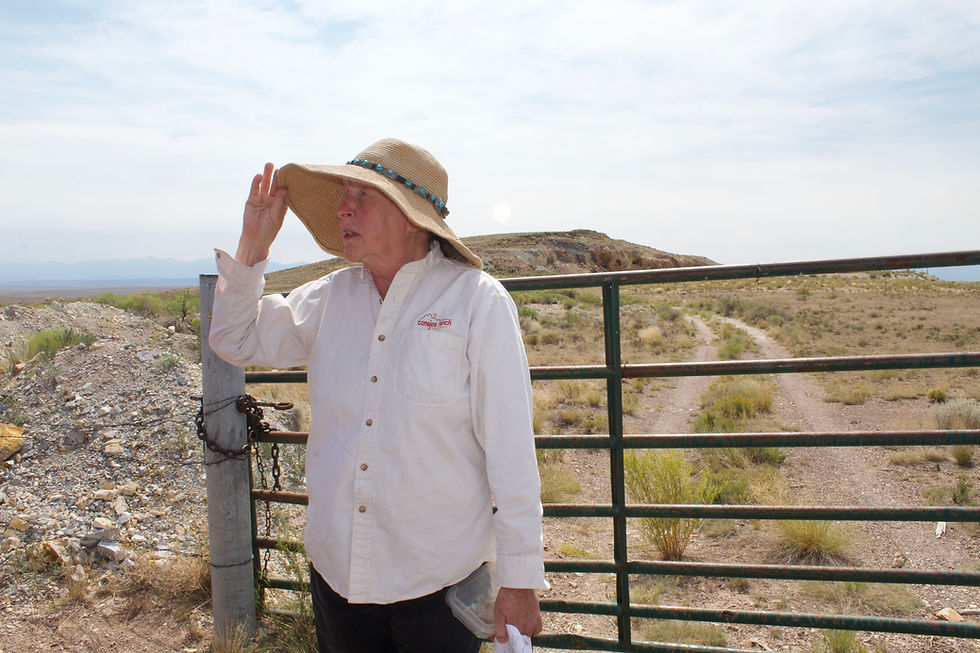SLVEC hosts public officials to explore heritage hotspots along Rio Grande corridor
- Kaitlyn Fletcher
- Aug 14
- 3 min read
Updated: Aug 15
PRESS RELEASE
Guided by local historian Loretta Mitson, more than 20 individuals trekked along the Rio Grande corridor that deserves preservation, such as a National Conservation Area (NCA), on Friday, August 8th. The San Luis Valley Ecosystem Council (SLVEC) hosted this excursion to get public officials and community members out onto the landscape recommended for this designation.
“This region may seem desolate,” Mitson said, “but the stories bring the landscape alive with vivid detail.”
Each stop, concentrated along the Rio Grande, showcased a heritage hotspot that paints the deep roots of 13 millennia of human occupation in Conejos County.

The caravan began in the town of Manassa, crossing the Conejos River en route east toward the Rio Grande corridor. The first stop was the King Turquoise Mine. After her first of many history lessons, Mitson points to the black leather belt inlaid with turquoise on her floppy straw hat. She recognized the distinct details in this garage sale treasure as from the King Mine.
Each mine produces turquoise with unique, identifiable characteristics. These deposits sport a blue-green hue with a golden brown matrix. Actively mined by the Native Americans for centuries, these valued gemstones have been spotted on Aztec ruins in Mexico. This provides evidence of trade routes between these Indigenous groups, dating back 700 years. It is believed to be the oldest known prehistoric turquoise mine in North America.
The next stop sits in the Rio Grande Natural Area — a 33-mile stretch that protects a quarter-mile strip adjacent to the meandering waters from the Alamosa National Wildlife Refuge to the New Mexico border.
We strolled across the two-lane highway, “like a herd of elk,” someone comments, to a game blind that overlooks a wash between the volcanic hills. Formed by an ancient lava flow, this wash is encased in thick, layered basalt. This is the largest game blind that Mitson has seen in the region, which could suggest the group hunt techniques of the Folsom and Clovis cultures. Some sites also display archaeological evidence, such as fluted spear points, of these nomadic tribes.
Back at the Rio Grande, Mitson shares the complex tale of the DeVargas Crossing in the summer of 1694. To avoid ambush, Governor Don Diego de Vargas rushed hundreds of his troops, native guides, and pack animals across the Rio Grande. He raided native food supplies for the desperate, developing Santa Fe community. Before the Rio Grande Dam, completed in 1914, these wild, deep waters raged at 200 feet wide. In 1861, the cabled Valdez Ferry began its operation at this site.
The caravan drove along miles of dirt roads to the actual DeVargas Crossing for a picnic lunch of sandwiches, juicy peaches, and lemonade. After lunch, Mitson pointed out remnants of Indigenous people, such as fire stones and earthen pottery shards, on the rugged rock outcrop overlooking the Rio Grande.
“This is how it should be. No trace left behind… well, besides our tire tracks,” said SLVEC director, Chris Canaly, as we pulled out of our scenic lunch spot.
Our final stop was at the Costilla County Crossing, locally known as Lobatos Bridge. It was the largest crossing west of the Mississippi back in 1892. Made in Canton, Ohio, the materials were transported by train, hauled in wagons, and then assembled on site. It sports a rare Thatcher double truss design. A sign on the east side states that the bridge can support 8 tons. We climbed down to the banks to admire the petroglyphs.
“Sharing our history with the next generation can help ease current tensions in Conejos County,” Mitson said. “We have a common story of cooperation in this Valley.”
-
Mitson received ‘A Lifetime Achievement Award’ to honor her 30 years of storytelling about the rich heritage of this region from the San Luis Valley Ecosystem Council, Sangre de Cristo National Heritage Area, and Adams State University Salazar Center.







Comments